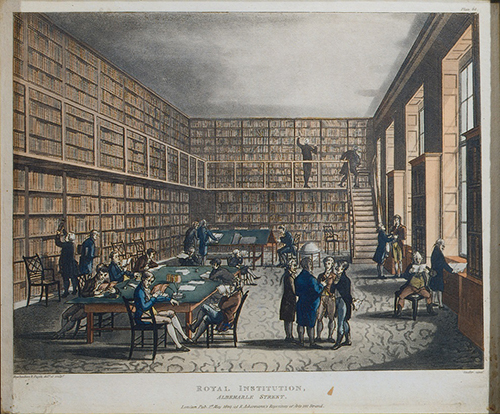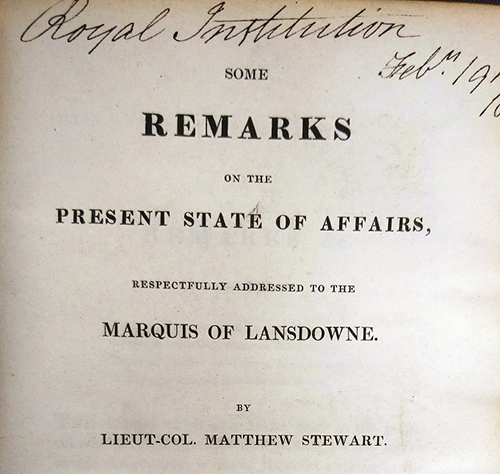A guest post by LH Member Laurence Scales. This article first appeared in London Historians Members’ Newsletter of August 2020.
______________________________________________________________________
Social media existed in the UK 200 years ago, thriving particularly just before new printing and paper technology led to cheaper books and to abundant periodicals with lively correspondence columns. The participants, including inevitably both windbags and trolls, were known as pamphleteers. Many were anonymous. Their (t)witterings were printed and their pamphlets typically ran to between ten and a hundred pages, and their subjects ranged from church tithes to timber rot.
As an archives volunteer at the Royal Institution (RI), founded 1799, I set out to review 2,500 pamphlets with a view to improving the catalogue, part of their collection of ephemera given ‘for the library’.

The Royal Institution Library from Ackermann’s Microcosm of London, an inaccurate depiction as there was never a gallery. Royal Institution of Great Britain.
‘Pamphlet’ includes any loose item given: some scientific papers, lecture transcripts and orations, and very many unsolicited opinions. I have so far only ventured as far as the 1830s. My selection of pamphlets for this article is whimsical. So, if you look forward to a discourse around the hot topics of the day such as the Corn Laws or the Reform Bill you will need to look elsewhere. I attach a few images of some pamphlets not covered in my text.
In those times, to sound off in public took a relatively greater amount of cash than it does today. But it appears that half of the well-heeled population of Mayfair was at it, and the library at the RI was an easy first drop off point for anyone with a bee in their bonnet and a barrow full of tendentious print.
The collection offers abundant examples of deplorable writing, the authors puffed up by force of indignation about ‘the present state of affairs’. So, fiery the indignation is, that it is often hard to penetrate and to know what ‘present state of affairs’ the writer was addressing.
Any charge or assertion made by one author was likely to stimulate, a few weeks later, a refutation by another.
Here are a few titles giving a flavour:
Monarchical Projects; or, a plan to place a Bourbon King on the Throne of Buenos Ayres, in Opposition to British Interests
Ode to her Imperial Majesty Catherine The Great presented by the Chief National School at St Petersburgh
Scripture Compared with Itself in the Proof of the Catholic Doctrine of the Holy Trinity
Short Remarks and Suggestions upon Improvements now Carrying on or Under Consideration
Letters from the Dorking Emigrants, who went to Upper Canada, in the Spring of 1832
An Appendix to the Supplemental Apology for the Believers in the Supposititous Shakespeare Papers
About the Family Tree of West Saxony. (In German)
Report of the Committee of the Westminster Medical Society on Arsenicated Candles
Some Remarks on the present State of Affairs, respectfully addressed to the Marquis of Lansdowne, by Lieutenant-Colonel Matthew Stewart

Royal Institution of Great Britain.
This last one has a typically pneumatic opening, dating from before the invention of KISS, ‘Keep it simple, stupid!’ and is as follows.
Remarks &c
The changes which have taken place in the political views of the great Parliamentary parties which divide the country, is one of the most striking of the many proofs which may be given of the influence of names in uniting men long after the principles which the names denoted have undergone a complete alteration. This, no doubt, is partly owing to the influence of those connecting causes which induced those who have acted together for any specific purpose, to continue in combination for the pursuits of common objects of policy. The experience of the necessity of co-operation, in order to produce an impression on the affairs of a free state, and the insensible gradation by which public measures change their aspect, may lead men very conscientiously to promote at one time objects very different from those which they have resisted at others, and therefore the pertinacious maintenance of offensive party badges and distinction is merely exciting useless animosities in society, and little better than cutting one-another’s throats about the colour of a Cameleon (sic).
And so on for a hundred pages. It seems to be a rant about political parties.
But it is not the flannel that makes fishing among the pamphlets fun, it is the nooks and crannies of history. Among the authors who did not hide in anonymity there emerge some curious characters.
One such was ‘bogus baronet’ Thomas Banks (1765-1854), who issued pamphlets on matters of peerage. Banks, we learn from the Oxford Dictionary of National Biography (1885), was ‘educated for the law, and on the strength of his genealogical knowledge proffered his services as an agent in cases of disputed inheritance… [H]e took an office, called the Dormant Peerage Office, in… Pall Mall. Although none of the cases he undertook possessed more than the very flimsiest claims, and there was scarcely any genealogical will-of-the-wisp which he was not ready, if the fancy struck him, to adopt as a reality, his researches, when his imagination was left unbiassed, were of the most thorough and painstaking kind.’
Another character was Edward Gibbon Wakefield (1796-1862) who wrote out of concern about crime. This was a man just out of Newgate prison. (But the date of the pamphlet is uncertain.) He was incarcerated there on a charge of child abduction, arising out of his marriage to a 15 year-old heiress at Gretna Green.
Dr Edward Wright (1788?-1859) presented a pamphlet of which he was the principle subject: Minutes of Evidence taken by the Committee Appointed to Inquire into the Charges Preferred against Dr Wright. He became house surgeon and superintendent at Bedlam Hospital in 1818, but was dismissed ‘for frequent drunkenness, neglect of duties and undue familiarities’.
Among the argumentative tracts there are some others with interesting data. The Annual Report of the Royal Humane Society, for example, lists the ‘receiving houses’ for the apparently drowned (where they might be revived). These included many well-known public houses near to water such as the famous London Apprentice and the Rosemary Branch alongside the Regent’s Canal.

Giant swan and shipwreck, a bizarre and inexplicable illustration from a Royal Humane Society Report. Royal Institution of Great Britain.
Vaccination was a recurring topic but one of the matters of greatest importance approaching 1831 was the threat of the Asiatic cholera. Its inexorable progress towards Britain took 15 years. It was a new disease. The cause of diseases was unknown, though bad smells were blamed, and chlorine was suggested by anatomist and pamphleteer Joshua Brookes as a palliative.
‘Of the utility of this plan, all the inhabitants residing in the vicinity of my late residence can bear testimony; for having received the body of a huge elephant for dissection about twenty years ago, in the hot month of August, the whole atmosphere became vitiated; but by the use of the above-mentioned chemical preparation the air was immediately purified.’
Thomas Pettigrew, surgeon, also offered some thoughts on cholera and elephants in his cholera pamphlet.
‘At Sumbhulpore an elephant had every symptom of cholera and was cured by brandy and laudanum.’

Chlamyphorus, or pink fairy armadillo. Exotic creatures were frequent topics. Royal Institution of Great Britain.
A rare pamphlet in the collection is architect Alfred Ainger’s 1830 proposal that London should avail itself of intercepting sewers, four years before artist John Martin made his better known proposal (and of course nearly 30 years before engineer Joseph Bazalgette began to implement such a scheme).
Charles Babbage fired a broadside at the effete Royal Society in a book called ‘Reflections on the Decline of Science in England’ which stirred up something of a hornet’s nest in pamphlet terms. A favourite hornet of mine was physician Augustus Bozzi Granville who counted how many useful contributions to knowledge the distinguished fellows contributed. We learn, for example, that none of the 63 temporal lords or noblemen who were fellows (FRS) contributed to the Philosophical Transactions over the period in question. Another who piled in was vexatious astronomer James South who complained that, ‘Many hundreds of the Society’s funds [were] converted into whitebait, rosewater, and Sauterne.’ Around this time the rival British Association for the Advancement of Science was founded.
A final category of pamphleteer (for now) was the crank. The illustrious vegetarian publisher Sir Richard Phillips, was very capable of fulminating expansively, if not comprehensibly, and railed against Newton in his ‘Protest against the Prevailing Principles of Natural Philosophy with the Development of a Common-Sense System’. Newton may be difficult but Phillips was impenetrable. There were also those determined in their assertion that they had squared the circle. One of these was miniaturist, Arthur Parsey, and another was a schoolmaster of Loughton. Mathematicians had long considered this to be an impossibility, though it was not proven so until 1882. But for some pamphleteers it beckoned like a pot of gold at the end of the rainbow.

Squaring the Circle. Royal Institution of Great Britain.
______________________________________________________________
Laurence Scales.
Laurence is a specialist guide and lecturer interested in the history of science, invention, engineering and medicine in London. He is [in normal times] a volunteer at the archives of the Royal Institution and Royal Society for the Encouragement of Arts, Manufactures and Commerce.
Leave a comment